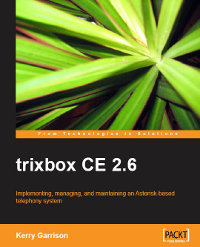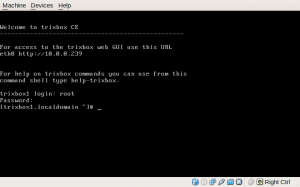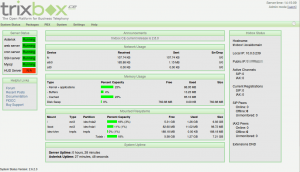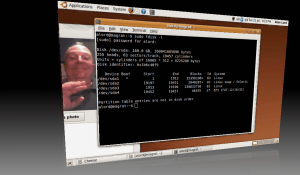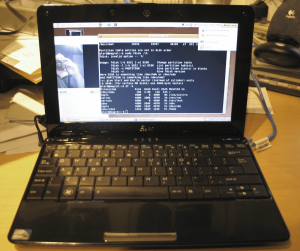Book Review: Trixbox CE 2.6 from Packt
[Please Note: If you use the book links from this site to Packt’s and decide to buy *any* book from their site, we will get a small commission that we’ll use towards the upkeep of our servers etc.]
Following on the heels of the Asterisk AGI Programming book review, Packt asked me to take a look at this one.
trixbox itself is a “packaged solution” comprising the operating system, Asterisk and a back-end/front-end configuration tool based on FreePBX. Personally, I’m from the “old school” when it comes to applications and I do like to know what makes them tick. So with Asterisk for example, when I first started looking at it I wanted to try and understand the configuration files and how it really worked so I installed from source and built everything from scratch. trixbox CE (Community Edition) on the other hand provides a user-friendly front end to Asterisk and wraps the whole thing up with an OS and delivers the bundle as a free download which is a ready-to-run ISO.
I guess one downside to the appliance package like trixbox is that you are tied into using the vendor’s choice of OS (CentOS in this instance) rather than your own. However, there are several advantages too: you know it works, has been tested all together and is supported, to whatever extent the community provides, by the producer. Anyway, this post isn’t a plug for Ubuntu or a review of the trixbox product itself. This is a review of a book about trixbox.
Before we get into the book though, for those who are unfamiliar with what trixbox is, their website tells us:
Beginning in 2004 as Asterisk@Home, the trixbox® Community Edition (CE) telephony application platform is the open source software that has quickly become the most popular Asterisk®-based distribution in the world. trixbox CE combines the best of the open source telephony tools into one easy-to-install package, along with the trixbox dashboard which provides a web-based interface to configure and manage a complete IP-PBX system. The most flexible and customizable communications platform available, trixbox CE averages over 65,000 downloads a month.
And the Wikipedia, in what must be one of the shortest pages in the entire Wikiverse, states:
Trixbox CE is 100% free and licensed under the GPLv2. Founding members of the trixbox CE project are Kerry Garrison and Andrew Gillis.
The trixbox CE brand is now owned by Fonality. Documentation, help and community forums can be found at www.trixbox.org
So that’s what the book is supposed to be telling us about. Let’s see if does…
It is subtitled “Implementing, managing, and maintaining an Asterisk-based telephony system” and written by Kerry Garrison. It’s quite a hefty tome weighing in at around 300 pages and is produced with Packt’s professional and easy-to-read layout & styling.
Chapter 1 is a brief introduction into the whole telephony scene covering subject such as what a PBX is. It then moves the reader toward an overview of the key features of Asterisk. For the most part the author has a good writing style and gets the information over with clarity. There is some good advice too; whilst obviously the author wants to explain why trixbox is the bees knees, he does make a very sensible comment early on:
While trixbox CE does make using Asterisk dramatically easier, it is certainly a good idea to really get in and learn all you can about the Asterisk configuration files. The more you know about how the system works under the hood the easier it will be for you to troubleshoot problems and even add features to your systems that aren’t available in trixbox CE.
Chapter 2 introduces the reader to trixbox itself:
- Going over some of it’s history,
- briefly mentioning the commercial trixbox packages available from Fonality,
- looking at the core components that make up trixbox
- trixbox features with lots of screenshots
- and what you will need to try out trixbox such as a PC, perhaps an analogue line card and a SIP phone.
There are lots of URLs scattered about where necessary directing the reader to further sources of reading or links to relevant vendors and downloads etc. For someone who is getting started this is a good resource and introduction.
In Chapter 3 we get shown how to install trixbox, even showing novice readers how to burn a CD if you happen to be unfortunate enough to be using Windows.
I followed this chapter through myself and installed trixbox CE 2.6 in a VirtualBox VM. The instructions were good with plenty of screenshots and comments guiding the reader through the process. (Just FYI, on my PC Lobsang, the entire install in a Virtual Machine took just about 3 minutes!. During the first boot up I noticed that it uses the excellent OSLEC echo canceller by default. That’s a plus mark from me.)
Continuing through the chapter, after installing and doing a
yum update we are guided to the browser interface of trixbox…
The rest of Chapter 3 explains the various screens and basic navigation techniques to get around. Once again, I’d say the book is comprehensive and has plenty of screenshots and comments.
I’m not going to write about every chapter because, to be honest, the rest of the book is equally well put together and covers the subject in detail. Chapters 3 to 11 are what a good manual would be like. Having digested these chapters, the reader will know a good deal of how (and perhaps more importantly why) to plan, select hardware, install, setup, configure and maintain a trixbox system. There is plenty of “extra” information thrown in that explains what various features or aspects of the system are for and how they work. References to external sources abound and other vendors are given a decent mention where appropriate. Simply put, it’s good. If you want to use or manage a trixbox CE system this book would be an excellent resource in my opinion.
The final part of the book, Chapters 12 to 17, provide somewhat more orthogonal, but nevertheless valuable, information. We get to find out a little about:
- troubleshooting techniques and also where else to go to learn further skills,
- some of the additional trixbox utilities that are available like the endpoint manager,
- the basics of designing a decent callflow for the IVR,
- an introduction to a new end-user interface called HUD (Head Up Display),
- and an overview of the commercial trixbox Pro products.
In summary then, this is another good book from Packt that hits all the right buttons. It is well written, very detailed, and has good explanations of technologies and applications related to IP telephony.
As to it’s main purpose, that is explaining how to deploy and use trixbox CE, in my opinion this what a decent product manual should be like.
Taxing Times for Free Choice [Updated]
It seems, unfortunately, as though my experience with Amazon was not common place.
Neil Wilson left a comment this morning explaining that his request to Amazon did not meet with the same response as my own…
We are not in a position to offer a partial refund for this product. You can of course return the laptop to us for a full refund if you wish
This appears to be in breach of consumer protection law and, more to the point Microsoft’s own EULA which, if you read it, and then decide to not accept it, clearly states:
“If you do not agree to the terms of this EULA, you may not use or copy the SOFTWARE, and you should promptly contact Manufacturer for instructions on return of the unused product(s) for a refund in accordance with Manufacturer’s return policies.â€
Some may try and suggest that “product(s)” means the computer in question, but since when have Microsoft started licensing the computer hardware of unknown manufacturers? The EULA is written for the protection of their software, not for some arbitrary computer of which they have little or no knowledge.
Amazon – This is not good. You really do need to do the right thing. I am sure that if you ask Asus, AIUI, or whoever else supplies your computers they will be able to reclaim the License cost from Microsoft and pass it back to you.
Unfortunately, it seems as though Amazon are not the only ones trying to ignore consumers and force us to pay for software we have no need of, nor desire for. Enter Ebuyer (a UK based “stack ’em high, sell em cheap” etailler)…
Here’s a potential customer’s question being answered this morning by Ebuyer’s E-Note system (E-Notes are Ebuyer’s way to avoid having to provide telephone numbers or email address so you can talk to real people)
Dear x,
Thank you for your response.
I have been speaking to the Product Managers for the Software and Laptops and they have both advised that we would not issue a refund on the OS.
You may return the product for a refund if you are within the time period of 28days after purchase but other then that we are not going to be issuing a refund on the OS.
The Product Manager for the laptops has been speaking to the manufacture and they have come back with the below response regarding the matter:
‘It’s a load of rubbish, I don’t know where this rumor has come from J we started getting people asking for it on the EEE PC when we first produced the XP versions.
We get the odd person phoning up saying this to us but no one gives the cost of XP back and I can understand why they think we would.
I’m sorry we cannot help — I have never heard of any manufacture or reseller giving the money back.’
Kind Regards,
y
Ebuyer Customer Support Team
Dear oh dear Ebuyer…
What a very strangely worded response. The internet is quite awash with people who have successfully claimed a refund for the Windows Tax. Please see this page for a consolidated list of many.
Asus, of whom the above message is referring are not doing themselves any favours by locking themselves into only supplying Microsoft’s Operating System. See this public letter regarding one buyer’s thoughts on the subject.
I would also like to bring to the attention of all vendors what the National Consumer Council, here in the UK, thought about EULAs in February 2008.
The National Consumer Council (NCC) has accused 17 firms, including Microsoft, Adobe and Symantec, of using unfair “end user licence agreements” (EULAs).
The NCC has asked the Office of Fair Trading to launch an investigation.
The NCC said the firms’ EULAs were misleading customers into “signing away legal rights”.
The NCC looked at 25 software packages and said that in 17 instances, the packaging did not tell potential buyers they would have to sign an EULA in order to use it.
While some contained the EULA inside an instruction manual, or let it be read online, this was only after the software had been bought.
“This means that consumers are unable to make informed decisions before they buy a product, yet are being forced to take on an unknown level of legal responsibility,” said the NCC.
After examining the contents of the EULAs, the NCC also said that some contained potentially unfair clauses.
Unfortunately, on the 1st October 2008 the Welsh, Scottish and National Consumer Councils merged with Postwatch and energywatch to form Consumer Focus. And did they maintain a historical record of the old sites? Not that I could find.
Anyway, it boils down to this:
Forcing people to buy something else with what they really want to buy is called bundling. It is now prohibited in France, and it is probably so in the UK too.
Perhaps these vendors need to read about the Sale of Goods Act again.
Neil Wilson described the situation very succinctly in an earlier comment on the same original post.
It is much better that the retail store pays, because they are the ones that are ultimately the channel to market. The more expensive it is for a retailer to stock Microsoft the better.
If the retailer is awkward, then the way to a refund is avoid the trap of following the instructions in the EULA. Instead you request that the retailer replace the software with a version that isn’t ‘faulty’ (ie doesn’t have the additional terms and conditions imposed). You didn’t agree to them when you purchased the item and therefore they don’t form part of the contract of sale with the retailer.
The Sale and Supply of Goods to Consumers Regulations 2002 requires that the retailer replace the faulty item, or if that is impossible provide you with a refund. The Sale of Goods Act gives you the right to partially reject items. Essentially you assert your ’statutory rights’.
I feel that we need to have a bit of a campaign here… Can I request that all readers of this post, especially in the UK, please pass it on, tell others and if you have the time, please write to your MP to make your opinion heard. It is disgraceful that we should be FORCED to pay for software for which we have no need nor desire. Microsoft seem to have successfully closed down many of the earlier Linux bundled netbooks through downright bribery or co-coercion I assume. It is not right.
This is the 21st century, there are other operating systems available which are superior in almost every way and, even better, are free. Just go and download Ubuntu if you don’t believe me and try it out for a few weeks…
[UPDATE]
Neil left a comment below. But just to make sure it doesn’t get overlooked he wrote:
Can I ask that all readers contact the OFT and request that they investigate the use of bundled software EULAs as an unfair practise under the new Unfair Trading Regulations 2008.
Thanks Neil, I’ll do that shortly. Sounds like a good idea.
[/UPDATE]
NB: There is a small but growing band of niche retailers and vendors who will sell you a computer with no operating system pre-installed. The choice is quite limited and the major manufactures seem incapable of escaping the grasp of Microsoft. But if you care to, do visit Naked Computers to see if there is a vendor that can help you.
Amazon’s Windows Refund Helps the Earth
On the 21st July 2009 I reported how Amazon had made it really easy for me to reclaim the cost of the Windows XP license on a new Asus netbook. This was a very popular post for my humble blog; especially after appearing on Slashdot thanks to reader and Digital Tipping Point producer Christian Einfeldt.
As a quick digression, I decided to install the 3rd Alpha release of the forthcoming Ubuntu Karmic Koala (what will be 9.10) on my netbook and it is working very nicely. I have discovered one problem with my 3G modem (an Option iCON 225), but this is alpha software and helping to test and find bugs is what it’s all about. I’ve confirmed the bug on Launchpad and will hopefully be able to help diagnose and rectify the issue as the Karmic release progresses.
Back to the topic.
What perhaps wasn’t as clear as it could have been (apparent by some of the dodgy reporting elsewhere) was that the netbook was a prize I’d won for helping to get testers to a Beta trial of the Micromiser energy saving software, specifically written for Linux, by a company called Miserware. As I hadn’t bought it the first place the refund was sent back to Miserware, not to me. That was absolutely fine. It was the principle I was interested in, not really so much about the money. I had thought that should the refund come to me, I would donate it to a deserving (IMHO) FOSS project. I hadn’t decided on any one particular project though as I was doubtful I would get the cash anyway. But that was my basic idea.
When the refund went off to Miserware, I mailed them to let them know it was coming and why. I also mentioned that I had intended to donate the refund and that it might be an idea for them to consider too. A couple of days later they emailed me back to ask if I’d mind them donating it to something a bit different. Not a free software project but something more in keeping with their “green” credentials. Hey! It’s their money; who am I to dictate what they do with it?
I thought it would be good to show you where the Microsoft Tax has gone:
Dear Melissa,
Thank you.
Your support will help the Sierra Club continue its efforts to protect wild places and endangered species, confront global environmental challenges, and keep the pressure on politicians and corporations.
By supporting the Sierra Club online, you also become a member of the Club’s Online Community — helping to save paper and postage and enabling you to get the latest environmental news and information quickly. As a member of our Online Community you can help protect the environment by visiting the Sierra Club Action Center and sending personalized emails to key decision makers on important conservation issues. And, at our Online Member Center, you can subscribe to one of the Club’s email newsletters and electronic publications.
The Sierra Club has been devoted to protecting our natural heritage for over 100 years. And thanks to your support, we can continue to fight and protect our natural resources.
Thanks again.
Sincerely,
Carl Pope
Executive Director
Sierra ClubPlease print or save this message for your personal records.
Name: Melissa Cameron
Amount: $67.58
Designation: Donation to the Sierra Club
The Sierra Club is:
America’s oldest, largest, and most influential grassroots environmental organization. Inspired by nature, we are 1.3 million of your friends and neighbors, working together to protect our communities and the planet.
I think that’s really cool. From over here in Europe, the USA isn’t exactly perceived as having a strong track record on green issues, although I’m sure that is going to change with the Bush era finally behind us. But nevertheless, it is great to see that there are organisations in the US that exist and promote the environmental agenda. If you’re a concerned American please go and stop by The Sierra Club and say hi… For all of us.
Windows is Dead (almost). Long Live Free & Open Source Software, i.e. Ubuntu
Finally.
My wife’s PC was the last bastion of proprietary software hell remaining in our home (and we have quite a few PCs). 2 days ago, Helen explained that she’d been having a nightmare with Windows. You’d start to login and immediately it would log you out again! Nice. And there was no easy way to prevent it. “Safe Mode” did the same thing. Very helpful – not. Googling threw up a lot of people with the same experience and some rather dodgy sounding workarounds to rectify the situation.
Helen has had a dual boot setup for a while, has been getting used to the nuances of Ubuntu and the Gnome desktop and is now fairly comfortable with it. So, rather than trying to fix an inherently broken OS we decided to make the switch. There was one caveat however; iTunes. Her work is a franchised music therapy business for elderly and disabled residential care homes. She uses a big iPod and iTunes to manage her many playlists etc., and all the music is in Apple’s lossless proprietary format. (I know, but I didn’t have an opportunity to suggest an alternative at the time…)
To make the move to Ubuntu as painless as possible I bought some more RAM and a 320GB HDD from Scan Computers to give her some more space and also just in case I ended up needing to do a fresh Windows install for a dual-boot setup. But my plan was to first of all attempt to use VirtualBox for the iTunes requirement. Unfortunately Wine didn’t seem like a viable option at this time.
After what seems like far too much effort, the iTunes Library is now hosted on our home server so it can be backed up easily. A VirtualBox (the closed source PUEL edition for USB passthrough) VM is running a fresh new install of XP and only iTunes, and it connects via a Samba share (Windows is configured to re-connect the network drive (Z:) on startup) to the music library.
The iTunes library was a complete PITA to move. There are lots of how tos and such like on the web but when it boils down to it, you need to check, very carefully, the structure in the iTunes Library.xml file so it matches the new location of the music itself. What didn’t help me was discovering, after several failed attempts, that iTunes at some stage in the past, had decided to create two complete “Compilation” and “Podcasts” directory structures, each with mostly different content, but some of it overlapping.
Essentially, the process is something like this:
- Backup the whole library!
- Create the new library location and copy in the data
- Delete the
*.itlfiles from the root of the iTunes library - Examine the
iTunes Library.xmlfile and use a good editor/comparison tool to alter all the paths so they point to the correct locations in your new library structure - Fire up iTunes, edit the Music Library location to where the new one lives
- Under the File menu (IIRC) you choose “import library” and point it at your modified
iTunes Library.xmlfile - Cross your fingers, toes and anything else 😉
Judicious use of that great comparison tool Meld and my eyeballs meant that finally I managed to restructure the library so it was consistent and not duplicated. I think that had it not been like this, my experience would not have been so bad or so lengthy, but iTunes will leave always a very nasty taste in my mouth. Also, had Windows not completely barfed (again) I would have been able to use the already installed iTunes app and move the library using it’s own built in tools (as this is apparently possible according to the interweb).
Probably the next step will be to introduce Helen to Songbird (or similar) and see if we can migrate the library, playlists and music across to that. I’ll do some playing on my own before suggesting it though. Small steps to catchy monkey I think.
VirtualBox 3.02 seems to be really good though. The USB pass through and auto-filtering is just brilliant (so Ubuntu doesn’t alert when you plug in the iPod when the VM is running; it goes straight through to the Windows VM). It does seem to take quite a long time for the whole Windows/iTunes thing to settle down after I’ve plugged the iPod in but it might be just because it’s a big 120G iPod anyway… But it isn’t a major issue.
So, although Windows isn’t completely dead in our household, it is certainly on its very last legs. And good riddance to it to.
Asus 1008HA with Ubuntu 9.10 Karmic Koala Alpha2
Following my earlier post about getting the Microsoft Tax on the Asus netbook refunded very efficiently and painlessly by Amazon, I’ve been doing a little reading, formatting, re-partitioning, installing and updating.
The newest PC in The Open Sourcerer’s household is now duly christened, cleansed and freed from proprietary software hell and will, from this moment forth, be known as Magrat. All our machines are named after characters from the Discworld novels by Terry Pratchett.
I thought I’d take a quick screenshot:
That’s me being filmed by the built-in webcam and I have printed a list of the disk partitions showing that there are now no NTFS or FAT left. The fourth partition was already on the disk and is for Asus’ “Boot Booster” utility which, from what I can tell simply dumps the BIOS and the results of some the POSTs into this partition and it causes the unit to get from power up to grub in about 1/2sec flat! So I thought I’d leave that one for now.
I re-partitioned the HDD to have a 15GB Ext4 partition for /, about 135GB for /home using ext3, and a 2GB swap partition.
Apart from a minor hiccup early on with the eth0 device disappearing, probably due to my incompetence rather than anything else, everything seems to be working as it should. The Wifi was detected, the screen looks great, the webcam, speakers and mic all work. I chose Karmic as the WiFi hardware for this netbook is a fairly recent addition to the Linux kernel and although it seems to be supported in the more recent Jaunty kernels, there still seemed to be some issues on various forums, whereas one contributor reported a perfect install using Karmic very recently.
So here’s the Asus Eee 1008HA PC running the regular Desktop version of Ubuntu Karmic Koala 9.10 Alpha 2 (I’ve removed several stickers from the area below the keyboard. These were telling me about some proprietary OS that I didn’t want in the first place):
I may well use the UNR (Ubuntu Netbook Remix) edition one day, but I do like having Compiz and multiple desktops around; something that doesn’t really “fit” with the UNR interface. But the cool thing is I have the freedom to choose…
For those interested in knowing more about the hardware of the Asus 1008HA, here’s the output of lshw, lspci -v, and dmidecode.
Monomania affecting Ubuntu users far and wide?
Last night in bed I was reading some more of a novel (Not Novell) called “The suspicions of Mr Whicher“. It’s an interesting book, based on a true story about infanticide in the middle 1800s and one of our very first real “detectives”. But I am finding it a bit on the “dry” side truth be told…
Anyway, about 1/2 way through the book I discovered something amazing. A reference to a psychological condition called:
Monomania
How on earth could a 19th century detective know about the long running saga of a rather large and bloated software stack designed, it seems, simply to drive a wedge into the FOSS community and act as a trojan horse for our most [ahem] loved convicted monopolist?
The Wikipedia informs us that:
Monomania (from Greek monos, one, and mania, mania) is a type of paranoia in which the patient has only one idea or type of ideas. Emotional monomania is that in which the patient is obsessed with only one emotion or several related to it; intellectual monomania is that which is related to only one kind of delirious idea or ideas.
In colloquial terms, the term monomania is often attached to subcultures that to the general public appear esoteric. However, the differences between monomania and passion can be very subtle and difficult to recognize.
Truth is, of course Mr Whicher couldn’t have known. No one could have written such a tale of intrigue, double-crossing and skulduggery. But then neither could one have imagined the horrific tale of poor little Saville Kent’s untimely demise.
I was minded to post this piece mainly because I had just read a rather well put together history of the Mono saga so far by The Mad Hatter.
If this story doesn’t contain any monomaniacs then I’m a March Hare!
